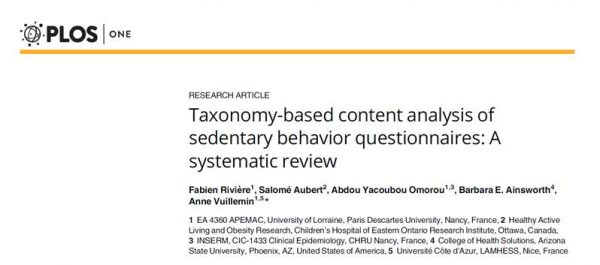
Do we fatten our kids in front of screens? Yes, no, maybe, it depends!
March 14, 2018Sedentary behaviour mechanisms: biological and behavioural pathways linking sitting to adverse health outcomes
April 6, 2018Today’s post comes from researchers Salomé Aubert and Fabien Rivière, and describes their recent review of the content of sedentary behaviour questionnaires. More on Salomé and Fabien can be found at the bottom of this post. Their full paper is available for free here.
Background
Sedentary behaviours (SB) are defined as “as any waking behaviour characterized by an energy expenditure ≤1.5 METs while in a sitting, reclining or lying posture” [1]. Health effects of sedentary time have been studied over the past decade with most studies showing negative associations between sedentary time and health outcomes in both adults and youth [2–4]. Much of the evidence for these results has been provided by self-report [2] with the majority of the studies measuring television (TV) viewing or total sitting time derived from a single question [4,5].
Measuring TV viewing or total sitting time may not provide enough information to understand the health effects of SB. An individual can engage in different types of SB including TV viewing, using a computer, reading, writing, and eating which have several purposes including work, transportation, and leisure time. Some studies have shown that the associations between SB and health-related outcomes vary by the characteristics of the SB measured and in the manner in which sedentary time is accumulated [6–8]. To advance knowledge of the effects of SB on health outcomes, it is important that multiple characteristics of SB can be assessed. Because of the ease of use and low burden, questionnaires often are used to recall detailed information about SB.
Therefore, the objectives of our new study were to examine and compare the content of the questionnaires measuring SB based on a well-defined and standardized classification of SB.
What did we do?
To identify as much SB questionnaires as possible three databases we searched for articles that report the development and/or the psychometric properties of self-report questionnaires to assess SB. The literature search produced a total of 1369 hits. When selecting articles based on the inclusion criteria, 82 studies were retrieved and three additional articles were identified based on hand-searching of existing reviews for a total of 60 questionnaires.
The content comparison aimed to identify the SB characteristics measured by each questionnaire for each item. To allow the comparison and analysis of the questionnaires, the decision was made to link the SB characteristics measured to the taxonomy of SB [9]. The taxonomy served as a reference framework to identify and classify the different categories of SB (see full article).
What did we find?
Overall, our review reports wide differences in the questionnaires’ content. Questionnaires ranged from 1-115 items with the most comprehensive questionnaires measuring up to 27 SB characteristics while the least comprehensive questionnaires measured only one characteristic, overall sitting time.
All the questionnaires except two assessed time spent in SB with 17 assessing frequency and 6 assessing breaks in SB. As we were expecting, most of the questionnaires measured sitting time spent watching TV or using a computer during a day. Facets for time, posture, purpose, and type were measured most often and facets for environment, social context, status and associated behaviours were measured least often.
What did this article add?
Considerable variability was observed in the comprehensiveness of SB in the questionnaires reviewed. When selecting a SB questionnaire, one should consider the measurement properties, the characteristics of SB, and the nature of information about the frequency, duration, interruptions, and recall frame. The taxonomy-based content analysis provides a useful tool to identify and compare the content of SB questionnaires as it provides a framework of SB characteristics with which to evaluate questionnaires. This review provides support for the development of questionnaires that measure SB characteristics not currently measured in existing questionnaires.
About the authors

Salomé Aubert, MSc, is a PhD candidate in Population Health at the University of Ottawa working under the supervision of Dr. Mark Tremblay. You can follow her on Twitter @SalomeAubert.

Fabien Rivière recently graduated from a PhD in physical activity and public health at the University of Lorraine in France, under the supervision of Pr. Anne Vuillemin and Pr. Barbara Ainsworth.
References
- Tremblay MS, Aubert S, Barnes JD, Saunders TJ, Carson V, Latimer-Cheung AE, et al. Sedentary behavior research network (SBRN)–terminology consensus project process and outcome. International Journal of Behavioral Nutrition and Physical Activity. 2017;14(1), 75. https://doi.org/10.1186/s12966-017-0525-8.
- 2. Biswas A, Oh PI, Faulkner GE, Bajaj RR, Silver MA, Mitchell MS, et al. Sedentary time and its association with risk for disease incidence, mortality, and hospitalization in adults: a systematic review and meta-analysis. Ann Intern Med. 2015;162(2):123-132. http://dx.doi.org/10.7326/M14-1651.
- Chau JY, Grunseit AC, Chey T, Stamatakis E, Brown WJ, Matthews CE, et al. Daily sitting time and all-cause mortality: a meta-analysis. PLoS ONE. 2013;8(11):e80000. http://dx.doi.org/10.1371/journal.pone.0080000.
- Tremblay MS, LeBlanc AG, Kho ME, Saunders TJ, Larouche R, Colley RC, et al. Systematic review of sedentary behaviour and health indicators in school-aged children and youth. Int J Behav Nutr Phys Act. 2011; 8(1):98. http://dx.doi.org/10.1186/1479-5868-8-98
- Atkin AJ, Gorely T, Clemes SA, Yates T, Edwardson C, Brage S, et al. Methods of Measurement in epidemiology: sedentary Behaviour. Int J Epidemiol. 2012;41(5):1460-1471. http://dx.doi.org/10.1093/ije/dys118.
- Healy GN, Dunstan DW, Salmon J, Cerin E, Shaw JE, Zimmet PZ, et al. Breaks in sedentary time beneficial associations with metabolic risk. Diabetes care. 2008;31(4):661–666. http://dx.doi.org/10.2337/dc07-2046.
- Saunders TJ, Tremblay MS, Mathieu M-È, Henderson M, O’Loughlin J, Tremblay A, et al. Associations of sedentary behavior, sedentary bouts and breaks in sedentary time with cardiometabolic risk in children with a family history of obesity. PLoS ONE. 2013;8(11):e79143. http://dx.doi.org/10.1371/journal.pone.0079143.
- Kikuchi H, Inoue S, Sugiyama T, Owen N, Oka K, Nakaya T, et al. Distinct associations of different sedentary behaviors with health-related attributes among older adults. Prev Med. 2014;67:335-339. http://dx.doi.org/10.1016/j.ypmed.2014.08.011.
- Chastin SFM, Schwarz U, Skelton DA. Development of a Consensus Taxonomy of Sedentary Behaviors (SIT): Report of Delphi Round 1. PLoS ONE. 2013;8(12):e82313. http://dx.doi.org/10.1371/journal.pone.0082313.




